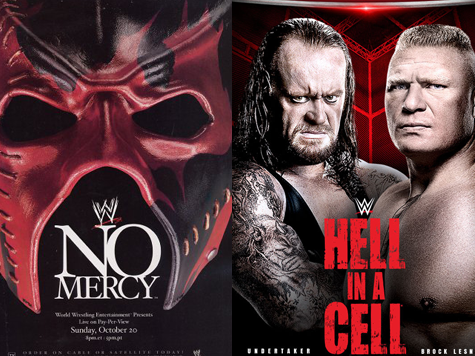Hell in a Cell 2015 airs on WWE Network Sunday, but I’m not entirely sure this isn’t a 2002 throwaway pay-per-view given the lineup. In fact, two of Hell in a Cell’s featured matches happened on the same card, this same month, 13 years ago.
Undertaker-Lesnar is the return engagement of a plodding match that headlined Summerslam, which was the rematch of one of Taker’s lesser Wrestlemania moments, which was a rematch of their abortive feud from 2002-2003.
This very match headlined No Mercy in October 2002, during Lesnar’s mega-push as WWE’s cornerstone for a new generation. Lesnar debuted earlier that year and ran roughshod over the roster, destroying the Hardy Boyz, Rob Van Dam, Hulk Hogan and The Rock on his way to the short-lived Undisputed WWE Championship.
Given the reign of dominance that was the Summer of Lesnar 2002, furthering cementing him as the company’s building block against Undertaker only made sense. WWE was in a transitional period then, with The Rock on his way out toward Hollywood; Steve Austin’s spinal problems and brief animus toward Vince McMahon; and, at 37, Undertaker neared semi-retirement.
Undertaker hadn’t yet adopted the part-time schedule that he’s been on for much of the last decade, but after 12 rock-solid years in the WWF/WWE, he was slowing down. A line of succession was needed, and Brock Lesnar was at the front of a line that also included John Cena, Randy Orton and Batista.
To that end, Lesnar’s 2002 Hell in a Cell match with The Dead Man served a big-picture purpose. The same can’t be said of Sunday’s encounter in Los Angeles.
Undertaker is on an even-more-abbreviated, part-time schedule, though at 50, should be near full-time retirement. His extremely limited appearances would be best served putting over a new generation of wrestler.
Lesnar isn’t exactly winding down. The time he spent away from wrestling after that monster push in the early 2000s preserved him both as a character and physically. But as a special attraction with limited dates in his contract, Lesnar also isn’t the same kind of cornerstone for WWE that he was 13 years ago when he first beat Undertaker in the Hell in a Cell.
The Beast snapping Undertaker’s WrestleMania streak at XXX was perfectly fine for reestablishing Lesnar as a dominant monster, a characteristic somewhat damaged the previous ‘Mania when Brock lost to Triple H. Lesnar needed to be built back up as an unstoppable destroyer in order to cultivate his status as a special attraction.
Much like the 2002 Hell in a Cell match, it succeeded. So why are both wrestlers’ limited appearances being wasted on multiple, unnecessary encounters between the two?
WWE is in a transition period now as it was in 2002. Lesnar is a part-timer, and while Randy Orton and John Cena aren’t nearing retirement, they have held the spotlight for a decade.
The time is now to build new stars, which WWE creative seemingly gets, having ended the last two WrestleManias with Daniel Bryan and Seth Rollins winning the World Heavyweight Championship. But from that launching point, the company’s writers don’t quite seem to understand how to further build their new, top stars.
Rollins’ run as champion will seemingly carry over into the next WrestleMania, but by then, will anyone have reason to care?
His reign has been more toothless than any “dominant” heel run I can remember, dating back to Chris Jericho in — wouldn’t you know? — 2002. Rollins retains the title, and he puts on great matches while doing so, but he’s made to look like a chump at every turn.
Heels relying on dirty tricks and chicanery is Pro Wrestling 101, but Seth Rollins’ version of this classic booking tactic looks equivalent to the next James Bond film revealing Mr. Bean as the leader of SPECTRE.
In a move that rather nicely crystallizes WWE’s impotent efforts to establish the new generation as premier attractions, Seth Rollins defends the World Heavyweight Championship at Hell in a Cell against Kane.
Kane was in this very spot, challenging for the title, at No Mercy 2002. He faced Triple H in what was the blow-off to arguably the single most embarrassing angle in professional wrestling history.
For those who don’t know to what I am referring, I’ve got two words for ya: Katie Vick.
Horrific storyline aside, Kane-Triple H at No Mercy 2002 at least made sense as a semi-main event title match. Triple H was being pushed as the company’s top heel and Kane had only been in the federation five years at that point.
He debuted October 1997 in, coincidentally, the first Hell in a Cell match.
Thirteen years and several gimmick changes later, Kane is a much less credible threat to an opponent WWE is trying to portray as its top heel. Imagine if at No Mercy 2002, Triple H defended against an upper mid-carder from 13 years prior.
Bad as the Katie Vick angle was, it could have been worse had it been Triple H vs. Ted DiBiase.
Because Kane isn’t a feasible main eventer at this point in his career, there’s little allure to Sunday’s World Heavyweight Championship match. Perhaps sensing that, Shawn Michaels was brought onto this week’s Raw in a segment with Rollins.
Now, Michaels had just come out of retirement in 2002, two months before the No Mercy card, and at that time was booked as the grizzled veteran trying to prove himself in a new era.
Michaels is in full-time retirement now, but that didn’t stop HBK from making Seth Rollins look like a goober.
WWE continues to flail over missed projections on Network subscriptions, but booking retreads of 13-year-old shows isn’t exactly the most appealing strategy to attract new fans.




















